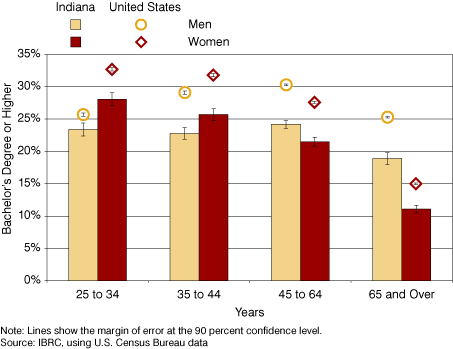Higher Education: Women Take Lead
The latest educational attainment data from the U.S. Census Bureau show that more women under the age of 45, at both the state and national level, have earned a bachelor's degree or higher when compared to their male counterparts.
These data come from the 2007 American Community Survey and all differences reported in this article are statistically significant. For more information about using margins of error and statistical significance, see the article "The Search for Significance: A Crash Course in Statistical Significance Using ACS 2007."
Looking at the population 25 and over, nearly 23 percent of men in Indiana have a bachelor's degree or higher, compared to just over 21 percent of women. This is due to the large male advantage in the oldest age group (see Table 1).
Table 1: Percent of Hoosiers with a Bachelor's Degree or Higher by Age and Gender, 2007
| Percent Bachelor's Degree or Higher | Male |
Female |
| Population 25 years and over | 22.8 (+/-0.4) | 21.4 (+/-0.3) |
| Population 25 to 34 years | 23.4 (+/-1.0) | 28.1 (+/-1.0) |
| Population 35 to 44 years | 22.8 (+/-0.9) | 25.7 (+/-0.9) |
| Population 45 to 64 years | 24.2 (+/-0.6) | 21.5 (+/-0.7) |
| Population 65 years and over | 18.9 (+/-0.9) | 11.1 (+/-0.6) |
Source: U.S. Census Bureau American Community Survey
However, when looking at the 35-to-44 age group, 25.7 percent of Hoosier women have a bachelor's or higher as opposed to just 22.8 percent of men. We see an even larger gap in the 25-to-34 age group, where 28.1 percent of women have a bachelor's degree or more, compared to 23.4 percent of men.
For women, the younger the age group, the higher the educational attainment—not surprising given the shift in women's working habits over the past several decades. One might expect a similar pattern to hold for men given the increasing importance of higher education in the job market; however, it is the men of the baby boom who have the highest percentage with a bachelor's degree or higher (refer again to Table 1).
While 24.2 percent of the male population between the ages of 45 and 64 have earned a bachelor's degree or more, that figure falls to 22.8 percent for the 35-to-44 age group, (a difference which is significant at the 95 percent level). However, it is worth mentioning that the attainment gap between men in the 45-to-64 age group and those in the 25-to-34 age group is not statistically significant, so we cannot conclude (with reasonable certainty) that the difference between the two is due to anything other than chance.
National Comparison
Before Hoosier women are overcome with a superiority complex, it is worth mentioning that Indiana lags the nation in educational attainment across the board (see Figure 1). For women, the smallest gap between Indiana and the United States is in the 65-and-older age group, while for men it is in the 25-to-34 age group. Therefore, even though male educational attainment in Indiana's younger age groups appears to have stagnated relative to the attainment of the baby boom generation, it compares fairly well to the national figure.
Figure 1: Percent of Male and Female Population with a Bachelor's Degree or Higher, 2007

Recent Changes
Between 2006 and 2007, only one measure has changed enough to register as statistically significant. We saw a 1.8 percentage point increase in the number of women age 35 to 44 with a bachelor's degree or higher (significant at the 95 percent confidence level). This could be the result of any number of factors: more women returning to school to get a degree; more educated women moving into the state; less educated women leaving the state; or a shift due to the changing age cohort.
Looking Ahead
Many of the fastest growing jobs of tomorrow will require at least a bachelor's degree.1 Indiana business and government leaders have cited education of our workforce as one of our most important issues. With this in mind, and as Indiana's economy continues to transition to a knowledge economy, it will be important that both our men and women bring the necessary skills and degree achievements to the table.
Note
- Rachel Justis, "Are the Well-Educated Coming to Indiana?" InContext, November 2006. Available online at www.incontext.indiana.edu/2006/november/2.asp
Rachel Justis, Geodemographic Analyst
Indiana Business Research Center, Kelley School of Business, Indiana University
